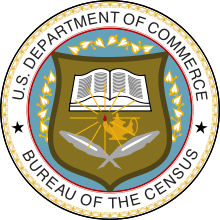1840 United States Census
The United States Census of 1840 was the sixth census of the United States. Conducted by the Census Office on June 1, 1840, it determined the resident population of the United States to be 17,069,453 — an increase of 32.7 percent over the 12,866,020 persons enumerated during the 1830 Census. The total population included 2,487,355 slaves. In 1840, the center of population was about 260 miles (418 km) west of Washington, near Weston, Virginia.
Controversy over statistics for mental illness among Northern blacks
The 1840 Census was the first that attempted to count Americans who were "insane" or "idiotic". Published results of the census indicated that alarming numbers of black persons living in non-slaveholding States were mentally ill, in striking contrast to the corresponding figures for slaveholding States.
Pro-slavery advocates trumpeted the results as evidence of the beneficial effects of slavery, and the probable consequences of emancipation.[1] Anti-slavery advocates contended, on the contrary, that the published returns were riddled with errors, as detailed in an 1844 report by Edward Jarvis of Massachusetts in the American Journal of the Medical Sciences, later published separately as a pamphlet,[1][2] and in a memorial from the American Statistical Association to Congress, praying that measures be taken to correct the errors.[3]
The memorial was submitted to the House of Representatives by John Quincy Adams, who contended that it demonstrated "a multitude of gross and important errors" in the published returns.[4] In response to the House's request for an inquiry, Secretary of State John C. Calhoun reported that a careful examination of the statistics by the supervisor of the census had fully sustained their correctness.[5][6] The returns were not revised.[7]
Census questions
The 1840 census asked these questions:[8]
- Name of head of family
- Address
- Number of free white males and females
- in five-year age groups to age 20
- in 10-year age groups from 20 to 100
- 100 years and older
- number of slaves and free colored persons in six age groups
- number of deaf and dumb, by race
- number of blind, by race
- number of insane and idiotic in public or private charge, by race
- number of persons in each family employed in seven classes of occupation
- number of schools and number of scholars
- number of white persons over 20 who could not read and write
- number of pensioners for Revolutionary or military service
Data availability
No microdata from the 1840 population census are available, but aggregate data for small areas, together with compatible cartographic boundary files, can be downloaded from the National Historical Geographic Information System. A compendium of data from the sixth census, organized by States, counties, and principal towns is available on the web site of the Census Bureau.
References
- ↑ 1.0 1.1 Leon F. Litwack (1958), "The Federal Government and the Free Negro, 1790-1860", Journal of Negro History 43 (4): 261–78, 263–68, JSTOR 2716144, and sources there cited.
- ↑ Edward Jarvis (1844). Insanity Among the Coloured Population of the Free States. Philadelphia: T.K. & P.G. Collins, Printers. Retrieved May 31, 2013.
- ↑ Edward Jarvis; William Brigham; J. Wingate Thornton (1844). Memorial of the American Statistical Association Praying the Adoption of Measures for the Correction of Errors in the Returns of the Sixth Census. Public Documents Printed by Order of the Senate of the United States, Second Session of the Twenty-Eighth Congress I (5). Retrieved May 31, 2013.
- ↑ John Quincy Adams (1877). Charles Francis Adams, ed. Memoirs of John Quincy Adams: comprising portions of his diary from 1795 to 1848. Philadelphia: J. B. Lippincott & Co. pp. 27–28, 61, 119–20. Retrieved May 31, 2013.
- ↑ Litwack (1958), 267
- ↑ John Caldwell Calhoun; South Carolina General Assembly (1859). Richard K. Crallé, ed. The Works of John C. Calhoun: Reports and Public Letters V. New York: D. Appleton and Company. p. 458. Retrieved May 31, 2013. Calhoun engaged William A. Weaver, the superintendent of the 1840 census, to review the figures and check them against related data from the 1830 census. Ibid. Weaver reported that he had examined "each specification of error" and concluded that the memorialists had themselves erred in their claims. While there doubtless had been minor errors, he said, there had been no glaring methodological mistakes as charged. See William Edwin Hemphill, ed., The Papers of John C. Calhoun: 1845, Columbia, S.C.: Univ. of South Carolina Press, 1993, vol. 21, p. 156.
- ↑ Litwack (1958), 268
- ↑ "Library Bibliography Bulletin 88, New York State Census Records, 1790-1925". New York State Library. 1981. Note that several pages on U.S. federal web sites incorrectly assert that the 1840 census questionnaire closely followed that from the 1830 census, which did not include questions concerning mental illness.
External links
- Compendium of the Enumeration of the Inhabitants and Statistics of the United States . . . from the Returns of the Sixth Census . . . . (Washington, D.C., 1841)
- Overview of the 1840 Census on www.census.gov.
| |||||||||||||
